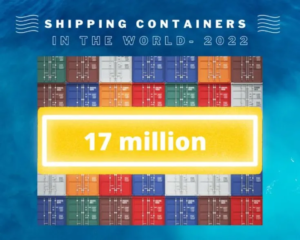NEWSLETTER – JANUARY 2023

Looking Forward to a Good Year for Shippers.
We expect 2023 to be a year of stabilised freight rates and space availability for our clients. Challenges with global freight and shipping supply chains are improving, and it’s going to make everything just a little bit better for consumers. Any reservations about the outlook for 2023 you might encounter will most likely be written from the point of view of shipping lines, who forecast an overcapacity and decline in utilization of vessels and containers this year – in other words, a downturn on last year’s profits. The anticipated combination of weak demand, easing congestion and increased freight capacity should actually be good news for importers and exporters. Analysts expect freight rates to gradually lower over the next six months and level out over the second half of the year.
At the start of the pandemic, global shipping supply chains slowed dramatically as online shopping fuelled a boom in demand. The worst of it was seen in 2022 while the backlog slowly cleared. It meant the cost of international freight went up. The backlog has cleared so the cost of shipping is beginning to drop, which means overseas items should arrive more cheaply and more quickly. Having said that, the world supply chain still has a few months ahead of it to sort itself out.
Note the dates for Chinese New Year coming up
For our many clients who trade with China, Hong Kong and Taiwan, please note the dates of the Chinese New Year holiday: 21 to 27 January 2023. This year it is expected to cause more delays to shipments than usual after the relaxation of Covid restrictions in those countries. Mainland China is likely to experience continued difficulty for workers travelling between cities and provinces, which may result in long delays in returning to work. We have received reports that many factories are likely to close two weeks earlier than usual for this reason.
Watching Out for ‘Hitchhiker’ Pests

Last month the Department of Agriculture, Fisheries and Forestry (DAFF) advised it would commence the new Asian Gypsy Moth (AGM) season as from 01 January 2023 and also announced a name-change for the bug – soon to be known as Flighted Spongy Moth Complex (FSMC). The heightened vessel surveillance window for the pest formerly known as AGM is between January and May each year.
As always, the BMSB, or Stink Bug as it is commonly known, featured in news throughout the past year. Over the Festive Season, importers were reminded that if they mix promotional gift items in with target-risk goods, containers will be assessed for BMSB at the highest risk level. The Stink Bug current season, which started on 01 September, is due to finish on 01 April 2023.
During the past year we had to deal with other pests such as the Khapra beetle and – one that is lesser known – the flight season of the Burnt Pine Longhorn (BPL) Beetle, which began on 19 November and will extend to April/May 2023. During this period, adult beetles are often intercepted at the Australian border on ships from New Zealand.
Recently DAFF also announced it was undertaking a survey in partnership with Qube Logistics – in the ports of Brisbane, Adelaide and Fremantle – to inspect the external surfaces of sea containers to verify if current risk-settings are effectively managing the challenge of hitchhiker pests and contaminants entering Australia. The survey commenced on 13 October 2022 with the intention to run for approximately 6 months.
New Year Customs Tariff Changes
Recently the Australian Border Force (ABF) issued notices confirming changes to come into effect from 01 January 2023. They are:
Peru-Australia Free Trade Agreement (PAFTA)
All goods that are Peruvian originating, other than excise-equivalent goods (certain tobacco, alcohol, fuel and petroleum products), will have a duty rate of ‘Free’ from 01 January 2023.
This final phasing down of duty rates under PAFTA applies to goods classified to approximately 75 subheadings. The duty rate for these goods will be phased down from a rate of 1.2% or 0.9% to ‘Free’. The goods affected by this reduction include preserved vegetables, chemicals, plastics, goods of plastics, rubber, leather, iron or steel, fibreboard, footwear and clothing accessories, machinery such as cameras and apparatus for radio-broadcasting, unmanned aircraft and furniture.
Regional Comprehensive Economic Partnership Agreement (RCEP)
From 01 January 2023 the preferential rates of customs duty for certain RCEP originating goods will be reduced to either 4%, 2% or 1%. As there are a large number of staging categories, importers are encouraged to check if there has been a change in the duty rate of their RCEP originating goods.
Australia-India Economic Cooperation and Trade Agreement (ECTA)
From 01 January 2023 the preferential rates of customs duty for certain Indian originating goods will be reduced to 3%. This phase down applies to 115 subheadings. The goods affected by this reduction are certain types of steel and iron and articles of steel and iron.
See our related article https://collessyoung.com.au/trade-deal-with-india-starts-29-december/.
Round-up of Trade Deals over the past month:

Visit to Europe and the UK to advance our trade diversification agenda.
Last month our Minister for Trade, Don Farrell, flew to Europe where he visited Paris, Brussels, and Berlin to advocate for the conclusion of important negotiations for an ambitious and comprehensive Australia-European Union (EU) trade agreement. In Bern, he opened the new Australian Embassy to Switzerland. In London, he advanced the Australia-UK free trade deal, highlighting that Australia has completed all domestic requirements to implement the agreement, and encouraged the UK to finalise remaining steps to ensure it enters into force early in 2023.
The IPEF Meeting in Brisbane.
Last month Australia played host to negotiators from 14 countries involved in the Indo-Pacific Economic Framework (IPEF) negotiating round in Brisbane, running from 10 to 15 December. Together, IPEF members represent over 40% of global GDP and, for Australia, eight of Australia’s top ten trading partners. They include the United States, Australia, Brunei, Fiji, India, Indonesia, Japan, South Korea, Malaysia, New Zealand, the Philippines, Singapore, Thailand and Vietnam – but not China. IPEF is described by the Australian Department of Foreign Affairs and Trade (DFAT) as ‘a modern regional arrangement to build cooperation and economic integration in the Indo-Pacific.’
RCEP Enters into Force for Indonesia.
The Customs Regional Comprehensive Economic Partnership Agreement, known as RCEP, has now entered into force for Indonesia as of 02 January 2023. The RCEP had already entered into force for Australia – as well as Brunei, Cambodia, China, Japan, Laos, New Zealand, Singapore, Thailand and Vietnam – one year ago. This was followed by the Republic of Korea on 01 February 2022 and Malaysia on 18 March 2022. The agreement is yet to enter into force for Myanmar and the Philippines.
China Relationship Warms Up
As 2022 drew to a close, there was a sense of optimism around the trading relationship with China, as Australia’s Foreign Minister Penny Wong made the first ministerial visit there in more than three years. The loosening of Covid restrictions in China has coincided with a surprising uptick in shipping demand. There will of course be some lag-time until the full effects flow through to industry, with financial analysts expecting that China’s reopening – defined as ‘a shift away from lockdowns’ – to come in the second quarter of 2023.
Containers in Circulation – Some Interesting Facts

How Many Containers are in Circulation?
Last year there were estimated to be over 17 million shipping containers in use worldwide – and the number is constantly growing.
If you lined up every shipping container on the planet, touching end-to-end, they would circle the equator about four times.
The average number of containers on a ship is approximately 15,000. That number can vary greatly depending upon the type of vessel and its cargo capacity. For example, larger ships can hold up to 24,000 containers, while smaller vessels may only hold 600.
One of the largest container ships in the world that often gets a mention is the MSC Oscar. It can carry over 19,000 TEUs (20-foot or 6-meter equivalent units) at once. That’s enough space for over one million refrigerators or 3 million laptop computers.
But when it comes to sheer size, no other container ship can compare to the HMM Algeciras. This gargantuan vessel is the largest on the planet at a whopping 400 m long and 61 m wide. It can carry up to 24,000 TEUs with a maximum load of 228,283 tons (207,095 MT). It is registered in Panama although, ironically enough, it cannot transit the Panama Canal due to its beam.
If you’d like to receive our Newsletter by email each month, send a message to Jayda jayda@collessyoung.com.au or Lisa lisa@collessyoung.com.au and they’ll be happy to add you to our list.

